The future of tanks in the light of the fighting in Ukraine
The ongoing hostilities in Ukraine have simply overturned a number of ideas about how the Armed Forces should be organized and equipped. This applies mainly to the Ground Forces, in the case of fleet what many authors have long warned about has been confirmed - the state of the fleet is inadequate to the threats, instead of development, its crude but expensive imitation takes place.
In the case of combat aviation also revealed the need for major changes.
But the Ground Forces have shown that what is needed is a complete revision of the concepts.
From approaches to planning operations, to the tactical and technical characteristics of military equipment, from the organization of a motorized rifle squad to the ranking of the combat properties of armored vehicles.
Previously, the author has already raised questions about how the troops are to change, for example, we can cite articles “How not to prepare for the last war instead of the next one?”, "Heavy armor for the Russian infantry" and a number of others.
In the proposed material, an attempt is made to briefly consider such an issue as the future of the appearance of tanks, in the light of how the fighting in Ukraine has changed.
In order to make some assumptions on this issue, it is worth starting with the differences in the conditions in which tanks actually operate from those for which they were created, and how their performance characteristics and design features correspond to these conditions.
Ukrainian battlefield
The fighting in Ukraine demonstrated the following specifics of the combat use of tanks.
Firstly, in the context of the unprecedented scale of the use of Javelin anti-tank systems, RPG NLAW, FPV-drones and heavy quadrocopters with mortar drop devices, the amount of ammunition hitting the tank in the roof exceeded all forecasts and calculations.
Prior to the entry of the RF Armed Forces into hostilities in Ukraine, there were various assessments in the expert community of the effectiveness of those anti-tank weapons that Ukraine received from Western countries, from dismissive to fear that they would bring heavy losses to our troops, along with statements that competent tactics and the interaction of tanks with other branches of the armed forces will reduce these losses to acceptable levels, but no one was really ready for what happened.
For the first few days, it seemed that Ukraine simply could not realize the potential of all anti-tank weapons, which she received, and in the long run, the Armed Forces of Ukraine had problems with NLAW, in particular with maintaining battery charge, but as a result, the losses of the RF Armed Forces in tanks from hitting the roof turned out to be unacceptably high, even without taking into account the so-called. "brooch".
Thus, the first trend is clearly drawn - now most of the tanks are hit not in the forehead, but in the upper projection.
Does this mean that now it is necessary to sacrifice frontal armor in order to increase the protection of the tank from being hit from above?
Literally, no. Just because in other conditions our tanks may well face massive fire from tank guns, and frontal armor cannot be sacrificed.
But how then to be? A technically equally protected tank cannot be realized.
Let's fix this as an important contradiction - you need to build up both the forehead and the roof, but in such a way as to remain in a reasonable mass of the hull and tower.
At the same time, an important point should be noted - no active defense system (KAZ) can protect a tank - simply because there can be too many attacks from above, massive and cheap FPV drones allow you to attack the tank many times, which will lead to the rapid shooting of all KAZ charges, and to the subsequent defeat of a tank that has lost its ability to defend itself.
Secondly, the situational awareness of the opposing sides on the battlefield had a major impact on the conditions for the combat use of tanks.
SWO in Ukraine - the first case in stories, where the situational awareness of even junior commanders is absolute - they can observe the entire neutral zone in front of their positions along the entire width of the sector of the front designated for defense or the offensive zone, and to a depth of several kilometers to more than ten. At higher command instances, awareness is even higher - up to tens of kilometers.
This was not the case before. Now it is almost impossible for a tank to reach direct fire range covertly, or at least so quickly as not to get under artillery fire and FPV drone strikes.
One of the consequences of this state of affairs was the massive use of indirect fire (ZOP), from a range of at least twice the usual range of actual fire on a visually observed target. In part, tanks have become self-propelled field artillery - but only in part, since traditional tank battles still take place regularly.
We can say that another task has been added to the traditional role of a tank on the battlefield - firing from the PDO from a range of 6-9 km.
At the same time, such shooting is not a new invention, this is how the Americans fired while they were armed with tanks with 90-mm guns, this is how our tankers fired in the 50s and 60s of the last century, until the tanks T- 62 with a smoothbore gun, which has a shorter barrel life than rifled guns, and the worst aerodynamic shape of a high-explosive fragmentation projectile.
Nevertheless, for modern tank troops, this is precisely a new form of combat use.
Thirdly, and this follows from the previous paragraph, the adjustment of fire from a tank gun with the help of a small unmanned aerial vehicle (UAV) - a quadcopter (copter) has acquired particular importance.
It was the copter that made shooting from a tank gun with a smooth barrel with a PDO quite accurate, especially in conditions when the firing tank and the UAV operator working with it have special software for adjusting fire (for example, by gaps observed from the copter).
As a somewhat specific feature of the conditions of the situation, it is worth designating the need to somehow ensure the very interaction with the copter - there is no place in the tanks for the UAV operator, there is no place for the copter either. Another important point is that with all the need for a copter, its control channel can often be detected by enemy electronic intelligence.
If we assume that a way to control the copter from the side of the tank is found, then such a tank will very quickly be hit by enemy artillery forces. And this problem also needs a solution.
Another important point - all of the above does not cancel all the previously existing requirements for tanks, since it is not at all a fact that the specific conditions of Ukraine will be completely repeated in the next wars, most likely, what the Armed Forces encountered in Ukraine will be combined with conventional conditions for the use of tanks.
Let's analyze how all the above features of the conditions in which tanks are used will change their appearance.
The threat from above and adaptation to it
First of all, it is worth detailing the issue not only taking into account the current situation, but also taking into account trends.
To date, loitering ammunition has appeared in the Russian Federation, capable of independently recognizing targets on the battlefield and attacking them. This is a further development of the now famous "Lancet", the so-called "Product 53".
Moreover, a group of enthusiasts producing FPV drones for the troops created a variant with homing, the operator just needs to take such a drone to an area where a target will fall into the field of view of his camera, and then he will aim at it himself.
It can be said that while the algorithms that control such attacks are imperfect, however, their polishing is a matter of no more than a year.
In 2024, strike UAVs that independently select and attack a target will already be commonplace.
The algorithm that selects a target for defeat in the viewed picture is not much more complicated than the one that selects a person's face when photographing the latter with a mobile phone. And this is where things start to get interesting.
If the homing system of a loitering ammunition or an FPV drone can independently detect a tank and aim at it, then can it aim at its vulnerable part?
So far, most likely not, but this, again, is an issue that can be resolved "within the year."
And now we look at modern tanks from above.
For example, the latest prototype of the T-14 Armata tank. It is perfectly clear that a sufficiently accurate loitering ammunition can hit directly into the hatch or near it.
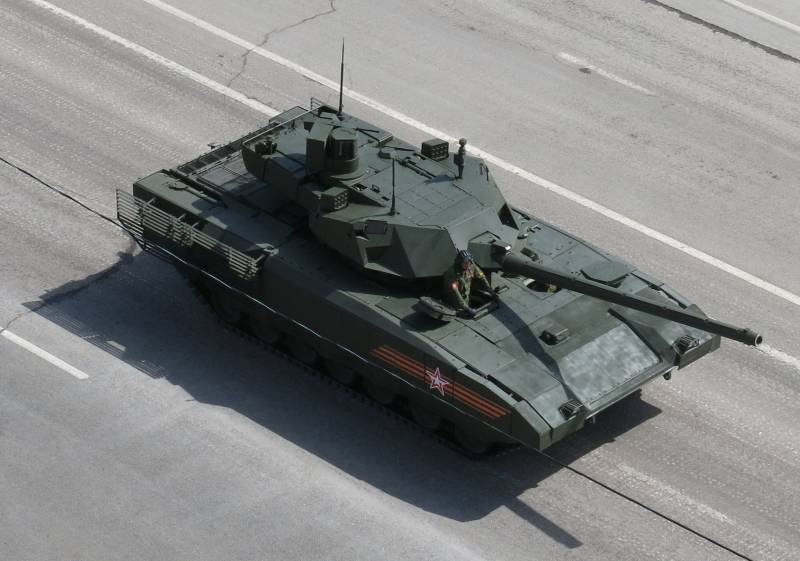
It must be clearly understood that the frontal armor of the tank is several times thicker than the top, and this cannot be fixed - an equally protected tank will be too heavy for any engine existing in the world and for tracks of any realistic width, it is unrealizable.
So - in the battles of the future "Armata" will fly directly into the roof of the habitable compartment.
Of course, some of the attacks will be beaten off by KAZ.
But to understand the scale - only one of the "creative associations" created with the help of Russian volunteers has delivered under 50 FPV drones to the front, and this cannot be compared with the capabilities of any military-industrial complex to supply missiles hitting a tank from above, such as those or Javelin. In the foreseeable future, cheap FPV drones will be able to be delivered to the front in the millions.
The expected number of roof-hitting weapons per kilometer of front has already increased by at least two orders of magnitude compared to old forecasts, and this is just the beginning.
No KAZ, no protection can cope with such an amount, the tank must have armor on top.
As a second example, let's take the American "Abrams" - a thin roof over the driver. Evil tongues claim that the rupture of a 100-mm projectile, driven into the joint between the hull and the turret above the driver's hatch, breaks through it with a shock wave and kills the driver. It is obviously difficult to check, but the armor there really will not withstand any serious impact, as, apparently, with the "Armata".
As a plus, the Americans can put a small width of the "coffin" of the driver - if it gets closer to any of the sides, it will not be the control compartment that will be hit, but the fuel tank, between which the mechanic driver of this tank is sandwiched. From above, it is partially covered by the gun barrel.
But ammunition, even with primitive artificial intelligence, may well get where it needs to be.
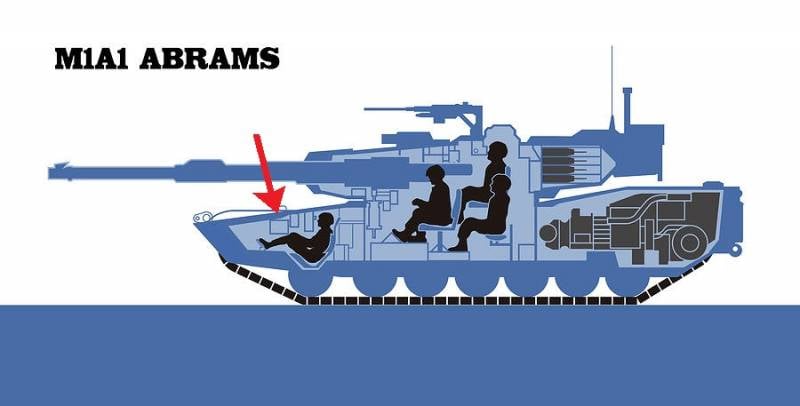
At the same time, you need to understand that these are not errors. The creators of the tanks proceeded from the installation, which was absolutely correct up to Ukraine, that the most likely for a tank is a projectile hit in the frontal projection - and up to a certain point this was the case. The frontal projection of all of them is protected. No one could predict how the battlefield would change.
What to do with the new threat?
The answer is that the architecture of the tank hull needs to be revised. Since it is impossible to combine the large thickness of the upper and lower frontal parts (VLD and NLD) and the roof of the hull and turret, then you will have to combine “two in one” - the VLD and the roof should become one part, and savings in mass should be ensured by minimizing its area compared to area of conventional VLD, NLD and roof.
Some ideal shape, which we now need to strive for, is shown in the figure below.
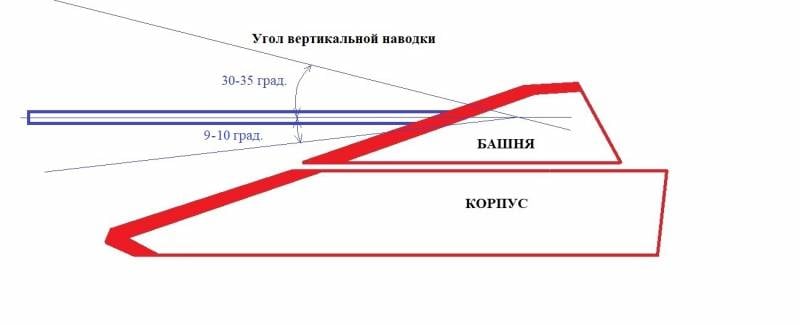
An unattainable goal is the shape of the hull, in which there is almost no roof, it is combined with frontal armor, both on the hull and on the turret. Due to this, mass is saved - there is no thick roof. This will have to be striven for. It is also worth paying attention to the angles of the vertical aiming of the gun - this is also very important
The tank has no hull roof and almost no turret roof, there are inclined armored parts: VLD / hull roof and frontal part of the turret.
The slope also provides high resistance to frontal shelling due to the armor angles, and at the same time provides increased protection from weapons that hit the tank from above.
Naturally, it’s easier to draw than to do, such a tank will have a lot of layout problems, it will not be convenient for the crew, the designers will have to suffer, providing, for example, the ability to leave a wrecked tank with a jammed turret, and, apparently, like this in its purest form It won't work, but that's exactly what you need to strive for.
In an interesting way, if we talk about the shape of the hull, then the Soviet tanks that have been criticized for many years in a row turned out to be closest to the ideal - for example, below - the T-72. It can be seen that the VLD was made within the framework of such an ideology, although the vulnerable area of \uXNUMXb\uXNUMXbthe hull - part of the turret sheet with the driver's hatch is still there.

The shape of the hull of Soviet tanks suddenly turns out to be much closer to the required one than anything else.
As for the towers, all the tanks in the world have them not adapted to protect against roof-hitting weapons, especially future loitering ammunition with autonomous homing.
What else needs to be noted?
Placing an ammo rack or an automatic loader in the aft niche of the tank turret now looks somewhat ambiguous.
On the one hand, such an arrangement really provides greater safety for the crew in case of fire in the ammo rack, but on the other hand, if even a penny FPV drone with weak non-tandem cumulative ammunition is hit in the knockout panels of the compartment with the ammo rack, the tank is guaranteed to be disabled.
Naturally, this does not mean that we should blindly go to the old Soviet scheme, but the Western scheme for placing an ammunition rack or an automatic loader in the aft niche of the tower is no longer adequate.
Now we are moving from layout solutions to active protection.
Of course, active protection is needed, moreover, there are certain developments in simplified detection systems compared to the Afghanit.
However, one must clearly understand that it is technically impossible to place KAZ ammunition sufficient for future threats on a tank.
What to do?
It is necessary to single out FPV drones as a separate threat and equip tanks with a separate tool to deal with it.
KAZ will have to deal with incoming missiles. With low-speed loitering ammunition compared to them and FPV drones, special machine-gun installations working in conjunction with KAZ will have to fight.
Practice shows that with a sufficient density of fire from small arms, a copter (and an FPV drone is, in fact, just that) can be shot down, as well as fragile loitering ammunition. The speed of these weapons is relatively low, and this gives some margin of time to fire at them.
Primary detection and target data (bearing, approximate range) can be issued by KAZ, then the installation should turn to aim at the target along this bearing and shoot.
Making an automatic guidance system for a machine gun that allows shooting down such small targets as a copter is not an easy task, but it can be solved.
However, the question arises of what the machine gun should be.
No variation of the Kalashnikov machine gun has the desired characteristics. Neither two- nor three-barreled installations based on such machine guns will provide the required density of fire.
The only solution is to use the GSHG-7,62 four-barreled machine gun as an “anti-drone” machine gun, which needs to be produced again.
Here, the Belarusian modification of this machine gun - 9-A-622, is of great interest, the difference of which is the use of an electric drive of the barrel block.
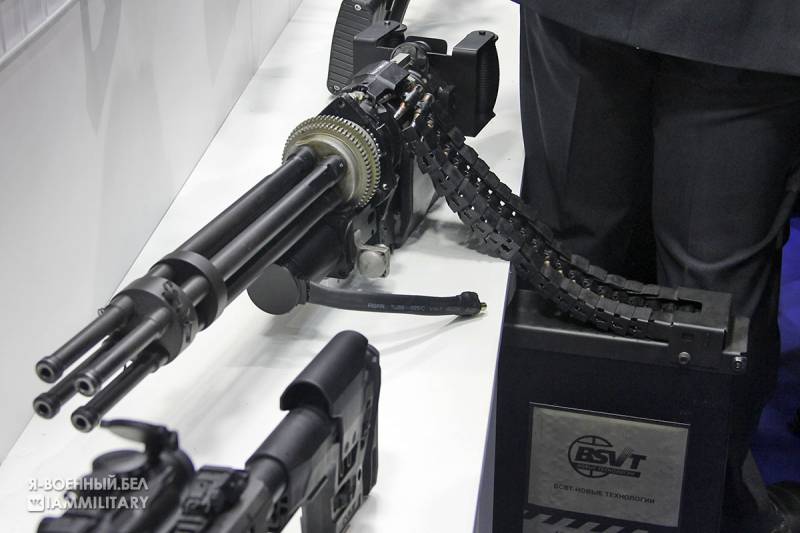
Machine gun 9-A-622. Approximately such a weapon should become the base for the "anti-aircraft guns" on the tank turret. Copyright on photo
Moreover, Belarus has developed a robotic fire system (ROK) "Berserk", armed with such machine guns.
Naturally, as soon as such an installation appears on the tank turret, then it is necessary to ensure the possibility of its use in manual control mode for targets other than air ones.
The next step in the creation of such installations should be the realization of the absolute insufficiency of the ammunition load of tank machine guns on our tanks. The GShG-7,62 and its Belarusian version have a huge rate of fire, and it will be necessary to create the desired density of fire.
And this means that the PKT machine gun ammunition numbers, traditional for Russia, measured by 250 rounds in a tape and a couple of thousand in total in a tank, will not work here. In truth, they are not suitable for coaxial machine guns either.
A simple example - in 2003 in Baghdad, holding strongholds inside the city limits for units of the 3rd Infantry Division turned out to be critically dependent on tank machine guns. Those interested can find some details of these fights on the Internet. What is important here? The fact that the Abrams tank has 11 rounds of 400 mm caliber for two machine guns and 7,62 rounds of 1 caliber for one heavy one. And they were used very intensively in Baghdad, having a decisive impact on the course of the battles for American strongholds.
To repel the massive attacks of FPV drones using a multi-barreled machine gun, you will need even more ammo. Moreover, it will not be possible to do the same as with the PKT, when there are 250 rounds of ammunition in the tape and after firing them the machine gun must be reloaded, the supply of cartridges must be continuous.
This goes against everything we've done before, but it's necessary if we don't want to lose expensive tanks and tankers to cheap FPV drones.
Shooting from a closed firing position
PDO shooting has become commonplace in the NWO, and, as mentioned above, the reason for this is the unprecedented level of situational awareness of the commanders of both sides. It is often simply impossible for a tank to be at direct fire range without falling under artillery fire.
There is no reason to believe that in future wars the level of situational awareness of the opposing sides will be lower, which means that this method of firing should be considered one of the regular ones, on a par with direct fire.
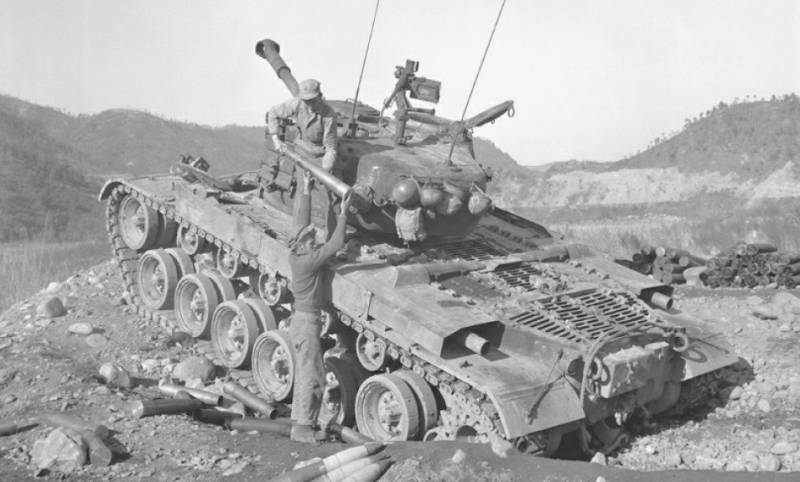
An American tank in Korea in a closed firing position, in this case with a ramp. Shooting without a ramp is also possible and applicable, only the range is less
Critical to long-range shooting is to provide a large vertical aiming angle (VAN).
Currently, for modern tanks, the limiting values of UVN are -10 ... + 20 degrees. This is enough for direct fire at any distance. However, for accurate shooting from a closed position at a remote, visually unobservable target, this may not be enough.
Thus, it is necessary that the tank of the future has a higher value of positive air pressure - 30–35 degrees.
There is nothing unique in such angles, for example, for a light amphibious tank PT-76, the UVN is -4 ... + 30 degrees. A negative angle of -4 is extremely small for a main battle tank, -9 ... -10 degrees is normal.
But thirty "up" is a completely different matter. With the same or greater angle, shooting becomes possible over long distances and without bulk ramps.
An example from artillery - for a 76-mm divisional gun ZiS-3 UVN (for artillery, the correct “elevation angle”) is -5 ... + 37 degrees, for a divisional 85-mm D-44, respectively -7 and +35, that is, if tank positive maximum UVN - +30 ... +35, then this is enough. But such an angle requires different approaches to designing a tank turret. Just like booking adequate to modern threats.
Also, perhaps a new fire control system is required, correlated with such a task as shooting from the PDO and the corresponding sights. In turn, PDO shooting requires a different, higher level of situational awareness, now for the tank crew as well.
Situational awareness and interaction with UAVs
It makes no sense to write about the gigantic significance of copters, literally everyone knows about it. In the case of tanks, small Drones critically important both for reconnaissance, in order to avoid falling into an ambush or a sudden collision with the enemy, and for adjusting fire when firing from the PDO.
Combat experience suggests that, generally speaking, there should be two people in the calculation of the drone - the pilot and the navigator.
This will not work with a tank, but one operator assigned to a tank will often be needed. A copter is critically needed by every tank crew leading the battle. And here we come across an organizational limitation.
We have no place in the tank for an unmanned aerial vehicle (UAV) operator, and there is nothing to use it, no storage space, no battery charging capacity, no place to store a spare UAV, replaceable batteries, etc.
There are no antennas for this.
That is, the only UAV operator who can theoretically help the tankers is external, and he will sit on the radio channel.
Which is already a problem, since the radio stations on our tanks, including new ones, are not really compatible with anything, except for other tanks.
But even without taking into account this specifically Russian problem, the tank today needs its own UAV operator, for which there is no place in it.
In the case of tanks of existing designs, the problem is unsolvable - there is nowhere to put an additional person, a place for him in theory can only be found in Israeli Merkavs and long-obsolete T-34s, which are not in service, and which in their current form are unsuitable for participation in modern military actions.
The newest tanks are almost all the same. In "Armata" tankers sit in a single compartment, three people in a row, and the Americans adopted the same crew placement for their promising Abrams X with an uninhabited tower.
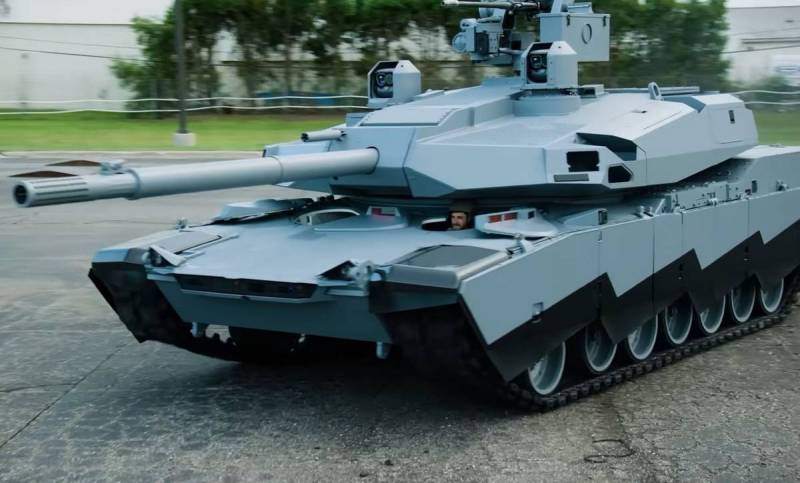
On Abrams X, the Americans repeated the layout of our T-14
At the moment, there is only one tank in the world that has a place for a specialist who is not part of the main crew, there is a separate control channel for unmanned aerial vehicles and a place for their placement.
This is a German experimental tank "Panther" KF51. This tank is equipped with an automatic gun loader, but instead of simply removing the gunner from the crew and reducing the armored volume, German engineers placed another crew member there, which means mainly the UAV operator.

Prototype of the main battle tank KF51 Panther. Photo: Wikipedia
With all the shortcomings of this machine, which is more of a concept demonstrator than a combat vehicle, unsuitable for mass production and has a lot of intractable shortcomings, it is impossible not to note the need for innovation with a reserve seat.
And this will also have to be repeated.
Before Ukraine, a crew of three was the main global trend, all tank-producing countries in the world were divided either into those who had already come to this, or those who would come to this.
Now the need to have a drone operator on board breaks this trend - now you need both an automatic loader and one more person in the crew.
Taking into account the previously stated requirements for armor, which will inevitably lead to a decrease in the usable volume in the tank, it will be very difficult to enter a fourth tanker there. But it will have to be done anyway.
The second tool that increases situational awareness will have to be a folding or telescopic mast with an optical-electronic surveillance or even sighting system that allows the crew to observe the situation from behind a vertical barrier, while remaining unobserved from the front.
Tank and quadcopter - integration in terms of technology
Let's outline what should be in the tank so that it can effectively interact with the copter.
In the minimum version, these are screens for displaying information from the commander and gunner, on which it would be possible to broadcast the image from the UAV cameras, moreover, the screens are color and larger, in the place of the UAV operator, too, plus a connector for connecting control points instead of the screen.
We need battery chargers, and with an eye on future new form factors, USB ports for charging from a portable charger or for charging a “power bank”. There must be a place to store quadcopters when folded, and a place for a case or stowage in which they can be carried out of the tank if necessary.
Antennas for controlling the copter via radio channel and a connector through which the use of an external antenna can be provided must be installed on the body.
The latter is very important, since often the Ukrainian artillery begins to work on the "illuminated" UAV operator within a minute or two after the start of work, their radio reconnaissance accurately detects the places where radio signals are emitted and the fact of data exchange between the copter and its operator.
On the one hand, there are ways to hide the fact that the radio control of the copter is working, there are technical solutions with directional antennas, a flight to the designated area without the participation of the operator is “on the way”, etc., but nevertheless, the ability to spread the tank and the antenna that unmasks it is needed, for example , when a dug-in tank in defense is used as a firing point.
Naturally, there should be such a trifle as a coil with an antenna cable protected from dirt, flames and theft.
At the place of the tank commander there should be a backup set of controls, in case of death or injury of the UAV operator.
If we don’t stop at the minimum, then we also need a landing pad on which the copter could be in motion without falling overboard and being protected from dirt, from which the operator could pick it up, including on the go, without opening his hatch (which is especially important, since with new approaches to the layout it is not known where this hatch will be located). Technically, such a platform is just a box attached to the tower, at the bottom of which there is a copter.
In a very luxury version, it will be a partially mechanized device in which the copters are stored, and from where they are launched, and where they then return to, if necessary.
Then you will have to somehow ensure the battery charge without human intervention, but the person will not have to leave the booked volume.
Another important innovation should be the ability to control UAVs over an optical fiber cable.
At the moment, it is the UAV control over the cable that is the only guaranteed way to avoid detection of its work by means of electronic intelligence. When operating in conditions where the operation of radio equipment will immediately cause an accurate artillery strike, the use of UAVs will be dangerous for the tank.
The cable is a solution for such a case, it sharply limits the maneuvering of the UAV, but does not unmask the tank in the electromagnetic range.
The copters should have a parallel cable control channel, and the tank should have a coil with an optoelectronic cable and a mechanism for releasing / reeling it so that the drone does not have to pull the cable with engines.
The cable should be located in such a way as to minimize the time spent by the UAV operator connecting it to the copter outside the reserved volume.
It is highly desirable that the tank, if necessary, be able to transmit the “picture” to other tanks or the unit commander to his tactical information display terminal.
This will require a completely different approach to communications than is shown in the RF Armed Forces, but it is really necessary so that one tank can be the eyes of a platoon or company, and the commander can receive more objective information than a voice report.
Other solutions
Closing the question, it is necessary to list a number of solutions that are either needed right now and can even be tested on existing tanks, or must appear in the future on tanks with the appearance features described in the article.
The first is the need to equip the guns with programmers for a programmable high-explosive fragmentation projectile and, by analogy with American tanks, an FMS capable of aiming such a projectile at an air target.
Shooting a projectile with a programmable detonation at helicopters is, of course, exotic, especially considering the range from which modern helicopters work on targets, but such a projectile will make it possible to effectively hit lying and even dug-in infantry. The combination of the ability to fire from the PDO, precise adjustment of fire from the UAV and a high-explosive fragmentation projectile with a programmable detonation will be a completely lethal combination for any enemy and will allow the tank to effectively deal with dispersed and dug-in infantry, being outside the range of the actual fire of its anti-tank weapons and its dug-in tanks, limited to direct fire.
At the same time, the high flatness of the trajectory of a tank projectile will make it difficult to determine the exact location of the counter-battery radar tank.
The second requirement follows from this requirement - the expansion of the ammunition line, which should include a projectile with a programmable detonation. But not only him.
Firing from closed firing positions requires a high-explosive fragmentation projectile with different aerodynamics, providing better accuracy when firing at extreme distances. Technically, the development of such a projectile is possible, and there is nothing to invent here, while old shells may well be used until stocks are exhausted.
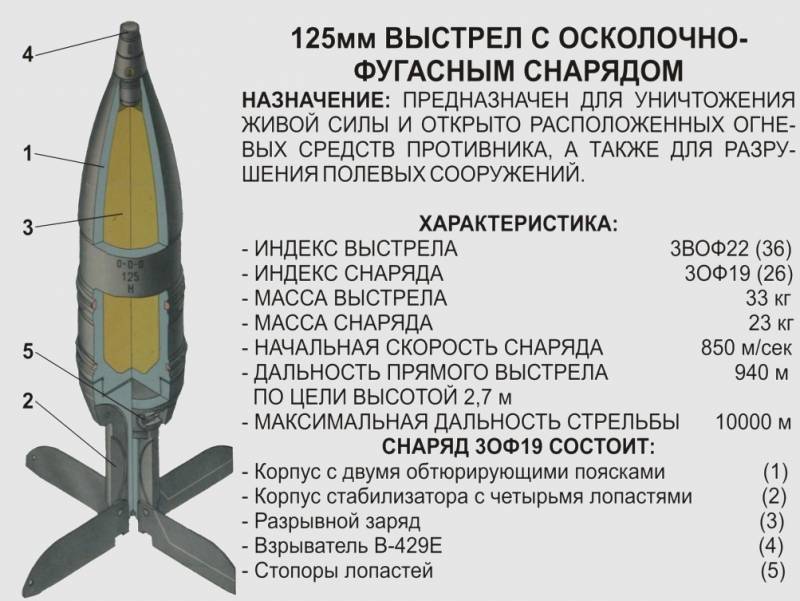
125 mm OFS. It can be seen that the aerodynamic scheme is far from perfect.
A laser-guided projectile looks logical.
Tanks now use guided missile rounds using a laser-beam guidance system, which require the gunner to observe the target being fired at through the scope and control the missile's flight.
And we should be talking about a high-explosive fragmentation projectile that could be aimed by infantry from the front line using a portable laser designator, while the tank would be behind the infantry battle formations.
Unusual, but requiring elaboration, is the idea of launching loitering ammunition through a tank barrel.
Being fired with a very weak explosive charge, such ammunition could be controlled by the UAV operator on board the tank through the standard UAV controls. Such ammunition could be used where it is impossible to hit a target with a conventional shot, for example, when an enemy tank is hidden behind a building.
This use of disposable kamikaze UAVs is more rational than what the Germans came up with in the Panther, where there is a separate launcher for 4 UAVs.
Apparently, the use of such ammunition will launch a new round of their evolution, which now can only be guessed at.
Also, the appearance of a modification of the Lancet strike UAV in the transport and launch container makes it possible to place such containers on the tank turret and use these UAVs as a strike tool if necessary.
It is necessary to multiply the ammunition load of the coaxial machine gun.
Another innovation is the need to install external telephone intercoms on tanks.
The “tank telephone” is intended for emergency communication of any serviceman with the tank crew; structurally, this is a telephone set installed outside the tank and connected to the tank intercoms of the tankers.
In an emergency, when a soldier does not have time to resolve the issue through his commander and the radio network of the unit, he, if the tank is nearby, can directly contact the crew, bringing to him information, for example, about a firing point that has shown itself, which the tankers do not see, or about that there are mines ahead on the road. This phone is not a substitute for radio communications and has a different purpose than radio communications between infantry and tankers. This is just an emergency.
The US Marines and Army have been using these phones since 1943. On the M1 Abrams tanks, the Americans removed the telephone, since the noise level from the gas turbine engine outside the tank is very high, and, as it was believed, it would interfere with talking, but after the start of the war in Iraq, the phones had to be returned, it turned out that it was inconvenient to fight without them, and losses in troops higher than they should be.
Similarly, since 2002, all main battle tanks of the British Armed Forces have also been equipped with such phones.
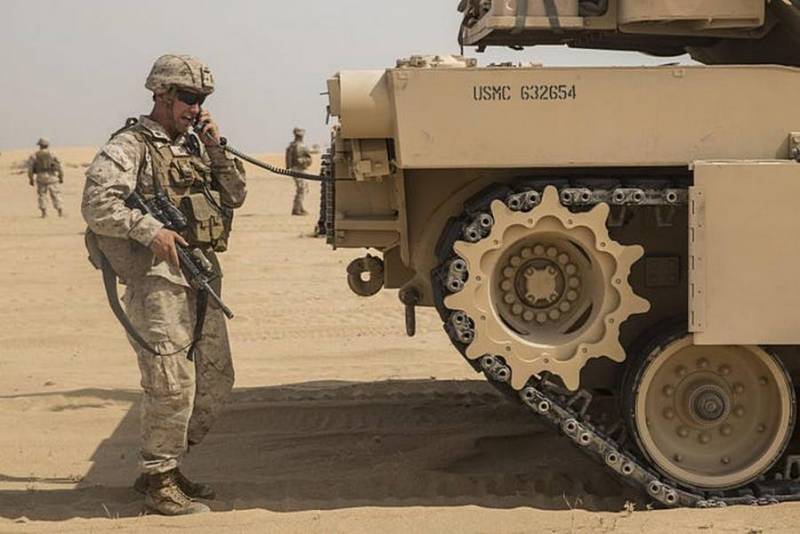
An American soldier talks to a tank crew in Iraq. Photo: Wikipedia
Unlike work for the future, equipping with telephones is also possible for combat tanks, and this must be done. However, now there are much more important problems with communication, but in the future, this one also needs to be addressed.
As for a promising tank, such phones should be on it right away, “by default”. Together with full-fledged communication systems, and not instead of them, of course.
The last thing worth noting is the gun.
For a long time, the inability of the domestic industry to create a sufficiently effective 125-mm armor-piercing projectile gave rise to a desire to switch to a larger caliber, which, in turn, gave impetus to the development of increased caliber tank guns, of which the implementation of the 152-mm 2A83 tank gun went the farthest.
The experience of fighting in Ukraine, however, showed that a 125-mm gun (in the future it will be 2A82) with the latest shells is sufficient to deal with any armored targets. Thus, the development of a 152-mm gun should be carried out as an experimental one for some distant future and work to achieve an acceptable barrel resource for this gun, but in general, with a high degree of probability, a 125-mm 2A82 or its further development in the same caliber will be sufficient for the future tank.
Conclusion
From the theory of evolution it follows that the fittest survives. Adaptability and adaptability to changing conditions, unfortunately, turned out to be not the strongest side of our society and the Armed Forces. The course of the Ukrainian conflict speaks precisely about this - there are changes, but they are completely insufficient, as a result, our country is still very far from victory, although the NWO has been going on for a year and a half.
However, this will not always be the case, moreover, under favorable circumstances, it will not be so for long. And this means that already now it is necessary to conduct a thorough analysis of the lessons of this SVO and work for the future.
Tanks are the backbone of the Ground Forces' strike power, but the military innovations of the NMD have led to a colossal increase in their losses in battles. Now an evolutionary leap is needed - tanks must adapt to new realities. This, apparently, will lead to the need to abandon those achievements that are now considered the latest, for example, the T-14 Armata tank clearly does not fully meet the new threats and does not ensure the realization of all the capabilities of the tank on the battlefield, its survivability against new threats will also be in question.
Perhaps it’s even good that this tank “didn’t work out”, and it’s worth using the experience gained during its creation to move on to a new project, taking into account the experience of the SVO in Ukraine.

Information